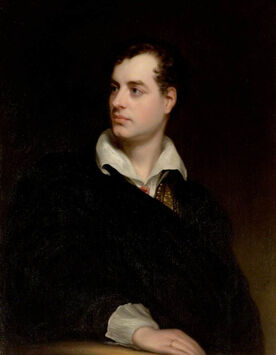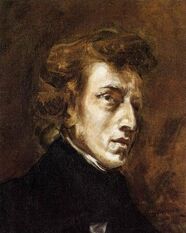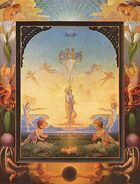m (→Fashion) Tag: Visual edit |
m (Spacing, grammar) Tag: Visual edit |
||
| Line 1: | Line 1: | ||
| − | {{Aesthetic|title1=Romanticism|decade_of_origin=1780s|key_motifs=The "Sublime |
+ | {{Aesthetic|title1=Romanticism|decade_of_origin=1780s|key_motifs=The "Sublime", Individuality and Subjectivity, Emotions, Nature, Sexuality.|related_aesthetics=[[Art Academia]]<br>[[Dark Academia]]<br>[[Light Academia]]<br>[[Romantic Academia]]|image1=Le_Desespere_by_Gustave_Courbet._.jpg|caption1=Le Desespere (1844-45) by Gustave Courbet.}} |
| − | '''Romanticism''' was an artistic, literary, musical and intellectual movement that originated in Europe toward the end of the 18th century, and in most areas was at its |
+ | '''Romanticism''' was an artistic, literary, musical and intellectual movement that originated in Europe toward the end of the 18th century, and in most areas was at its peak in the approximate period from 1800 to 1850. The movement developed in reaction against the rationalism of the [https://www.bl.uk/restoration-18th-century-literature/articles/the-enlightenment Enlightenment], and later on, against the materialism of the Industrial Revolution. |
| − | peak in the approximate period from 1800 to 1850. The movement developed in reaction against the rationalism of the [https://www.bl.uk/restoration-18th-century-literature/articles/the-enlightenment Enlightenment], and later on, against the materialism of the Industrial Revolution. |
||
| + | |||
| − | Romanticism, at |
+ | Romanticism, at its heart, values: nature, emotionality, subjectivity, and individuality. But above all, the Romantic strives towards the enigmatic ideal of the "sublime". Because Romanticism is so idealistic, it often aligns itself with Nationalism which is why the traits and visual tropes of Romanticism vary from country to country. However, this fascination with national ideals often resulted in a Romantic fertilization of non-western/European societies and cultures. |
== Fashion == |
== Fashion == |
||
| − | Nineteenth century Romantics generally wore their hair longer than the squares of the day, and would have probably worn more typically androgynous clothing. Their wardrobe consisted of silk scarves, looser jackets and pantaloons, straw hats, and a walking |
+ | Nineteenth century Romantics generally wore their hair longer than the squares of the day, and would have probably worn more typically androgynous clothing. Their wardrobe consisted of silk scarves, looser jackets and pantaloons, straw hats, and a walking stick—seeing as the Romantic loves to hike and walk through nature. |
| − | However, the Romantic ideal |
+ | However, the Romantic ideal of the young genius resulted in a trend towards looking sickly. Romantics often wanted to look consumptive—that is to say flushed and thin—and worshipped the premature deaths of Romantic poet John Keats (who died at the age of 25) and composer Frederic Chopin (who was 39), both of tuberculosis. |
== Texts == |
== Texts == |
||
| Line 42: | Line 42: | ||
== Music == |
== Music == |
||
| − | The cumulative Romantic musical form is the |
+ | The cumulative Romantic musical form is the symphonya form of music dependent on subjective experience and emotions. |
* Basics of Romantic classical music: https://open.spotify.com/playlist/7qXaPjzDlR7cbsweXbH0tu (by Spotify user pomooney). |
* Basics of Romantic classical music: https://open.spotify.com/playlist/7qXaPjzDlR7cbsweXbH0tu (by Spotify user pomooney). |
||
| Line 75: | Line 75: | ||
Mary Shelley, for example, but more modern examples of Dark Romanticism include Stephen King, Stephanie Meyer's Twilight series, and the modern, more-twisted variations of the Alice in Wonderland story in literally, as well as TV shows such as Supernatural, Chilling Adventures of Sabrina, Gravity Falls, and American Horror Story. Themes in Dark Romanticism include:</nowiki> |
Mary Shelley, for example, but more modern examples of Dark Romanticism include Stephen King, Stephanie Meyer's Twilight series, and the modern, more-twisted variations of the Alice in Wonderland story in literally, as well as TV shows such as Supernatural, Chilling Adventures of Sabrina, Gravity Falls, and American Horror Story. Themes in Dark Romanticism include:</nowiki> |
||
* Longing, window motive, wanderlust, escapism, wandering motive, somnambulism |
* Longing, window motive, wanderlust, escapism, wandering motive, somnambulism |
||
| − | * Nature: (ie, hiking trails, mountains, caves, deep water, dark |
+ | * Nature: (ie, hiking trails, mountains, caves, deep water, dark forests, lonely clearings; but also symbol-related animals, plants and natural phenomena such as fog, moonlight, thunderstorms, shadows) |
| + | |||
| − | <nowiki> </nowiki>forests, lonely clearings; but also symbol-related animals, plants and |
||
| − | natural phenomena such as fog, moonlight, thunderstorms, shadows) |
||
* Night, stars, moon |
* Night, stars, moon |
||
| − | * Places and buildings (like castles, haunted mansions, |
+ | * Places and buildings (like castles, haunted mansions, monasteries, dungeons, cellar vaults, tombs, artificial ruins, ruined architecture, cemeteries) |
| + | |||
| − | monasteries, dungeons, cellar vaults, tombs, artificial ruins, ruined |
||
| − | architecture, cemeteries) |
||
* Evil |
* Evil |
||
* Philosophy, theology, religion, doubts about faith, nihilism |
* Philosophy, theology, religion, doubts about faith, nihilism |
||
* Fantasy |
* Fantasy |
||
* Mythical creatures (ie. elves, fairies, ghosts, revenants, demons, shapeshifters and doppelgangers) |
* Mythical creatures (ie. elves, fairies, ghosts, revenants, demons, shapeshifters and doppelgangers) |
||
| − | * Femmes |
+ | * Femmes fatales |
* Para science, parapsychology, alchemy, magic, necromancy, occultism, satanism, witchcraft, magnetism |
* Para science, parapsychology, alchemy, magic, necromancy, occultism, satanism, witchcraft, magnetism |
||
* Paraphile eroticism, |
* Paraphile eroticism, |
||
Revision as of 23:24, 11 May 2021
Romanticism was an artistic, literary, musical and intellectual movement that originated in Europe toward the end of the 18th century, and in most areas was at its peak in the approximate period from 1800 to 1850. The movement developed in reaction against the rationalism of the Enlightenment, and later on, against the materialism of the Industrial Revolution.
Romanticism, at its heart, values: nature, emotionality, subjectivity, and individuality. But above all, the Romantic strives towards the enigmatic ideal of the "sublime". Because Romanticism is so idealistic, it often aligns itself with Nationalism which is why the traits and visual tropes of Romanticism vary from country to country. However, this fascination with national ideals often resulted in a Romantic fertilization of non-western/European societies and cultures.
Fashion
Nineteenth century Romantics generally wore their hair longer than the squares of the day, and would have probably worn more typically androgynous clothing. Their wardrobe consisted of silk scarves, looser jackets and pantaloons, straw hats, and a walking stick—seeing as the Romantic loves to hike and walk through nature.
However, the Romantic ideal of the young genius resulted in a trend towards looking sickly. Romantics often wanted to look consumptive—that is to say flushed and thin—and worshipped the premature deaths of Romantic poet John Keats (who died at the age of 25) and composer Frederic Chopin (who was 39), both of tuberculosis.
Texts

The Poet Lord George Byron (1788-1824).
The Key Texts of Romanticism:
Early Romantic Texts
- Lyrical Ballads (1798) by Samuel Taylor Coleridge and William Wordsworth.
- The Prelude (1799) by William Wordsworth.
- Songs of Innocence and Experience (1794) by William Blake.
Second Generation Romantic Texts
- Don Juan (1819) by Lord George Byron.
- She Walks in Beauty (1814) by Lord George Byron.
- The Mysteries of Udolpho (1794) by Ann Radcliffe.
- Ode on a Grecian Urn (1820) by John Keats
- Frankenstein (1823) by Mary Shelley.
Russian Romantic Texts
- A Hero of Our Time (1840) by Mikhail Lermontov.
- Eugene Onegin (1830) by Alexander Pushkin.
French Romantic Texts
- Les Miserables (1862) by Victor Hugo.
- Indiana (1832) by George Sand.
Music
The cumulative Romantic musical form is the symphonya form of music dependent on subjective experience and emotions.
- Basics of Romantic classical music: https://open.spotify.com/playlist/7qXaPjzDlR7cbsweXbH0tu (by Spotify user pomooney).
Romantic Composers

Frederic Chopin by Eugene Delacroix.
- Ludwig Van Beethoven (https://open.spotify.com/playlist/37i9dQZF1DX12YIlzNkccL).
- Frederic Chopin (https://open.spotify.com/playlist/37i9dQZF1DWV7cvDzE3MOI).
- Pyotr Ilyich Tchaikovsky (https://open.spotify.com/playlist/37i9dQZF1DX2kvBlhyEkb6).
- Franz Liszt (https://open.spotify.com/playlist/37i9dQZF1DX93wmY669mVj).
- Franz Schubert (https://open.spotify.com/playlist/37i9dQZF1DWY3VlkBR4Jhb).
- Hector Berlioz (https://open.spotify.com/playlist/37i9dQZF1DWWq1x4amZ5Ls).
Subgenres
Dark Romanticism
Dark Romanticism is a subgenre of Romanticism, reflecting popular fascination with the irrational, the demonic and the grotesque. It is characterized by the fact that it particularly emphasizes irrational, melancholic features and is also fascinated by the design of human madness and by Evil.
Often conflated with Gothicism, it has shadowed the euphoric Romantic movement ever since its 18th-century beginnings. At the end of the 18th century, ''Schauerrliteratur'' (Gothic Novel) developed in England as a separate style. In the 19th century, modern horror literature developed from black romanticism, like Edgar Allan Poe, Emily Dickinson, and Mary Shelley, for example, but more modern examples of Dark Romanticism include Stephen King, Stephanie Meyer's Twilight series, and the modern, more-twisted variations of the Alice in Wonderland story in literally, as well as TV shows such as Supernatural, Chilling Adventures of Sabrina, Gravity Falls, and American Horror Story. Themes in Dark Romanticism include:
- Longing, window motive, wanderlust, escapism, wandering motive, somnambulism
- Nature: (ie, hiking trails, mountains, caves, deep water, dark forests, lonely clearings; but also symbol-related animals, plants and natural phenomena such as fog, moonlight, thunderstorms, shadows)
- Night, stars, moon
- Places and buildings (like castles, haunted mansions, monasteries, dungeons, cellar vaults, tombs, artificial ruins, ruined architecture, cemeteries)
- Evil
- Philosophy, theology, religion, doubts about faith, nihilism
- Fantasy
- Mythical creatures (ie. elves, fairies, ghosts, revenants, demons, shapeshifters and doppelgangers)
- Femmes fatales
- Para science, parapsychology, alchemy, magic, necromancy, occultism, satanism, witchcraft, magnetism
- Paraphile eroticism,
- Drugs (ie. alcohol, opium, morphine, mushroom extracts, animal elixirs)
- Dream and reality, nightmares
- Melancholy, depression, resignation, despair, longing for death
- Hysteria, obsession, madness
- Expiration
- Death


